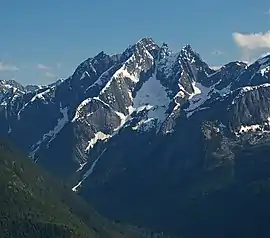Mount Rexford
Mount Rexford is a prominent 2,329-metre (7,641-foot) mountain summit located in the Cascade Mountains of southwestern British Columbia, Canada. It is situated 3.5 km (2 mi) north of the Canada–United States border, 7 km (4 mi) west of Chilliwack Lake, and 5.5 km (3 mi) east of Slesse Mountain, which is its nearest higher neighbor.[2] Precipitation runoff from the peak drains into Nesakwatch and Centre Creeks, both tributaries of the Chilliwack River. Originally known as Ensawkwatch, the mountain was named for an early settler in the area, Rexford, who had a cabin near Slesse Creek and had trap lines in the vicinity.[3][4] The mountain has two subsidiary peaks known as the Nesakwatch Spires. The mountain's name was officially adopted on June 2, 1950, by the Geographical Names Board of Canada.[5] Mount Rexford was first climbed in July 1951 by Herman Genschorek and Walt Sparling via the West Ridge.
| Mount Rexford | |
|---|---|
 Mount Rexford, north aspect | |
| Highest point | |
| Elevation | 2,329 m (7,641 ft) [1] |
| Prominence | 555 m (1,821 ft) [1] |
| Parent peak | Slesse Mountain (2429 m)[1] |
| Isolation | 5.34 km (3.32 mi) [2] |
| Coordinates | 49°02′01″N 121°31′27″W |
| Geography | |
 Mount Rexford Location in British Columbia  Mount Rexford Mount Rexford (Canada) | |
| Location | British Columbia, Canada |
| Parent range | Skagit Range North Cascades |
| Topo map | NTS 92H/4 |
| Geology | |
| Mountain type | Intrusive |
| Type of rock | Granodiorite |
| Volcanic arc/belt | Pemberton Volcanic Belt |
| Climbing | |
| First ascent | 1951 by Herman Genschorek and Walt Sparling[3] |
| Easiest route | Scrambling |
Geology
Mount Rexford is composed of granitic rock related to the Chilliwack batholith, which intruded the region 26 to 29 million years ago after the major orogenic episodes in the region. This is part of the Pemberton Volcanic Belt, an eroded volcanic belt that formed as a result of subduction of the Farallon Plate starting 29 million years ago.[6][7][8]
During the Pleistocene period dating back over two million years ago, glaciation advancing and retreating repeatedly scoured the landscape leaving deposits of rock debris.[9] The "U"-shaped cross section of the river valleys are a result of recent glaciation. Uplift and faulting in combination with glaciation have been the dominant processes which have created the tall peaks and deep valleys of the North Cascades area.
The North Cascades features some of the most rugged topography in the Cascade Range with craggy peaks and ridges, deep glacial valleys, and granite spires. Geological events occurring many years ago created the diverse topography and drastic elevation changes over the Cascade Range leading to various climate differences which lead to vegetation variety defining the ecoregions in this area.
Climate
Based on the Köppen climate classification, Mount Rexford is located in the marine west coast climate zone of western North America.[10] Most weather fronts originate in the Pacific Ocean, and travel east toward the Cascade Range where they are forced upward by the range (Orographic lift), causing them to drop their moisture in the form of rain or snowfall. As a result, the Cascade Mountains experience high precipitation, especially during the winter months in the form of snowfall. Temperatures can drop below −20 °C with wind chill factors below −30 °C. The months July through September offer the most favorable weather for climbing Rexford.
Climbing Routes

Established rock climbing routes on Mount Rexford:[1]
References
- "Mount Rexford". Bivouac.com. Retrieved 2019-11-04.
- "Mount Rexford, British Columbia". Peakbagger.com. Retrieved 2019-11-04.
- Fred Beckey, Cascade Alpine Guide, Volume 3 (Second Edition), The Mountaineers, 1995, ISBN 0-89886-423-2, p. 154
- "Mount Rexford". BC Geographical Names.
- "Mount Rexford". Geographical Names Data Base. Natural Resources Canada. Retrieved 2019-11-04.
- Cenozoic to Recent plate configurations in the Pacific Basin: Ridge subduction and slab window magmatism in western North America
- "Miocene peralkaline volcanism in west-central British Columbia - Its temporal and plate-tectonics setting" (PDF). Archived from the original (PDF) on 2011-07-06. Retrieved 2019-11-05.
- Catalogue of Canadian volcanoes: Franklin Glacier Archived 2010-12-11 at the Wayback Machine
- Kruckeberg, Arthur (1991). The Natural History of Puget Sound Country. University of Washington Press.
- Peel, M. C.; Finlayson, B. L.; McMahon, T. A. (2007). "Updated world map of the Köppen−Geiger climate classification". Hydrol. Earth Syst. Sci. 11. ISSN 1027-5606.
External links
- Rexford's west face (aerial photo): PBase
- Nesakwatch Spires Rock Climbing: Mountainproject.com
- Weather forecast: Mount Rexford